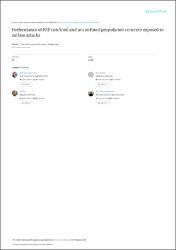Performance of FRP confined and unconfined geopolymer concrete exposed to sulfate attacks
Abstract
In this study, the effects of magnesium sulfate on the mechanical performance and the durability of confined and
unconfined geopolymer concrete (GPC) specimens were investigated. The carbon and basalt fiber reinforced polymer (FRP)
fabrics with 1-layer and 3-layers were used to evaluate the performances of the specimens under static and cyclic loading in the
ambient and magnesium sulfate environments. In addition, the use of FRP materials as a rehabilitation technique was also
studied. For the geopolymerization process of GPC specimens, the alkaline activator has selected a mixture of sodium silicate
solution (Na2SiO3) and sodium hydroxide solution (NaOH) with a ratio (Na2SiO3/NaOH) of 2.5. In addition to GPC specimens,
an ordinary concrete (NC) specimens were also produced as a reference specimens and some of the GPC and NC specimens
were immersed in 5% magnesium sulfate solutions. The mechanical performance and the durability of the specimens were
evaluated by visual appearance, weight change, static and cyclic loading, and failure modes of the specimens under magnesium
sulfate and ambient environments. In addition, the microscopic changes of the specimens due to sulfate attack were also
assessed by scanning electron microscopy (SEM) to understand the macroscale behavior of the specimens. Results indicated that
geopolymer specimens produced with nano-silica and fly ash showed superior performance than the NC specimens in the sulfate
environment. In addition, confined specimens with FRP fabrics significantly improved the compressive strength, ductility and
durability resistance of the specimens and the improvement was found higher with the increased number of FRP layers.
Specimens wrapped with carbon FRP fabrics showed better mechanical performance and durability properties than the
specimens wrapped with basalt FRP fabrics. Both FRP materials can be used as a rehabilitation material in the sulfate
environment.

















